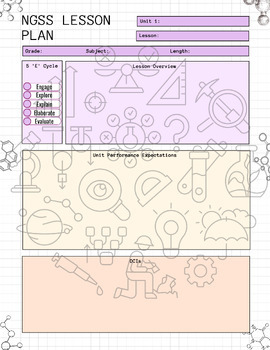NGSS Lesson Plan Template
TeacherMetamorphosis
1 Follower
Grade Levels
Not Grade Specific
Subjects
Resource Type
Standards
NGSSMS-PS3-4
NGSSMS-PS2-4
NGSSMS-PS2-3
NGSSMS-PS3-2
NGSSMS-PS4-1
Formats Included
- Google Slides™
Pages
4 pages
TeacherMetamorphosis
1 Follower

Made for Google Drive™
This resource can be used by students on Google Drive or Google Classroom. To access this resource, you’ll need to allow TPT to add it to your Google Drive. See our FAQ and Privacy Policy for more information.
Description
Elevate your curriculum planning with a meticulously designed NGSS (Next Generation Science Standards) Lesson Plan Template. This comprehensive and user-friendly template is a must-have tool for educators dedicated to delivering engaging and aligned science instruction. Whether you're a seasoned educator or new to NGSS, this template simplifies the process of crafting impactful lessons that meet the standards while fostering active student engagement and exploration.
Key Features:
- Aligned with NGSS: Our meticulously designed template aligns seamlessly with the Next Generation Science Standards, ensuring that your lessons target and effectively meet the required standards.
- Structured Framework: The template provides a structured framework that guides you through each phase of lesson planning, from setting objectives to assessment.
- Three-Dimensional Learning: Embrace the three dimensions of NGSS—disciplinary core ideas, science and engineering practices, and crosscutting concepts—in a cohesive and integrated manner.
- Differentiation Ready: Effortlessly modify activities in dedicated sections to integrate differentiation and support the diverse needs of each learner in their learning journey.
- Assessment: The template includes formative and summative assessment provisions.
Total Pages
4 pages
Answer Key
N/A
Teaching Duration
N/A
Report this resource to TPT
Reported resources will be reviewed by our team. Report this resource to let us know if this resource violates TPT’s content guidelines.
Standards
to see state-specific standards (only available in the US).
NGSSMS-PS3-4
Plan an investigation to determine the relationships among the energy transferred, the type of matter, the mass, and the change in the average kinetic energy of the particles as measured by the temperature of the sample. Examples of experiments could include comparing final water temperatures after different masses of ice melted in the same volume of water with the same initial temperature, the temperature change of samples of different materials with the same mass as they cool or heat in the environment, or the same material with different masses when a specific amount of energy is added. Assessment does not include calculating the total amount of thermal energy transferred.
NGSSMS-PS2-4
Construct and present arguments using evidence to support the claim that gravitational interactions are attractive and depend on the masses of interacting objects. Examples of evidence for arguments could include data generated from simulations or digital tools; and charts displaying mass, strength of interaction, distance from the Sun, and orbital periods of objects within the solar system. Assessment does not include Newton’s Law of Gravitation or Kepler’s Laws.
NGSSMS-PS2-3
Ask questions about data to determine the factors that affect the strength of electric and magnetic forces. Examples of devices that use electric and magnetic forces could include electromagnets, electric motors, or generators. Examples of data could include the effect of the number of turns of wire on the strength of an electromagnet, or the effect of increasing the number or strength of magnets on the speed of an electric motor. Assessment about questions that require quantitative answers is limited to proportional reasoning and algebraic thinking.
NGSSMS-PS3-2
Develop a model to describe that when the arrangement of objects interacting at a distance changes, different amounts of potential energy are stored in the system. Emphasis is on relative amounts of potential energy, not on calculations of potential energy. Examples of objects within systems interacting at varying distances could include: the Earth and either a roller coaster cart at varying positions on a hill or objects at varying heights on shelves, changing the direction/orientation of a magnet, and a balloon with static electrical charge being brought closer to a classmate’s hair. Examples of models could include representations, diagrams, pictures, and written descriptions of systems. Assessment is limited to two objects and electric, magnetic, and gravitational interactions.
NGSSMS-PS4-1
Use mathematical representations to describe a simple model for waves that includes how the amplitude of a wave is related to the energy in a wave. Emphasis is on describing waves with both qualitative and quantitative thinking. Assessment does not include electromagnetic waves and is limited to standard repeating waves.


